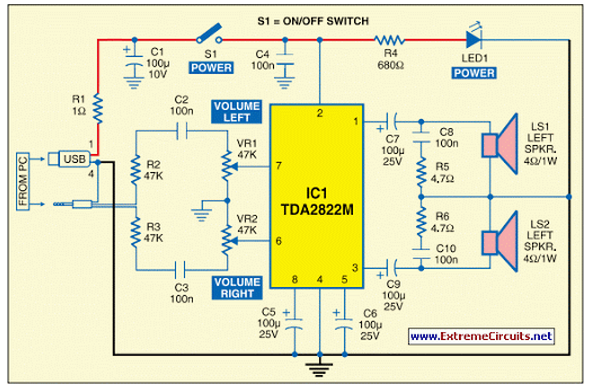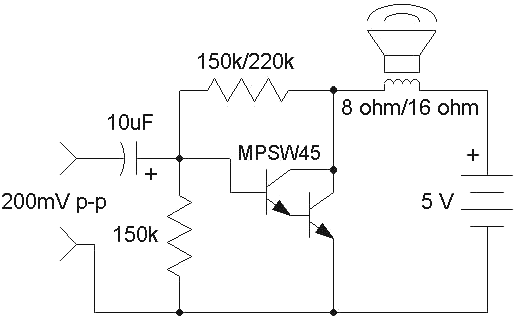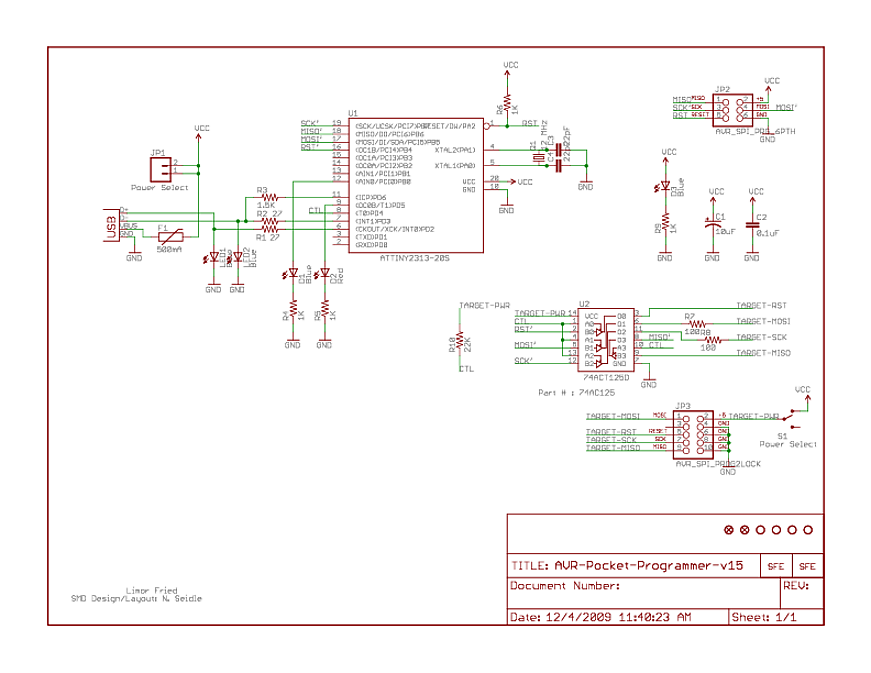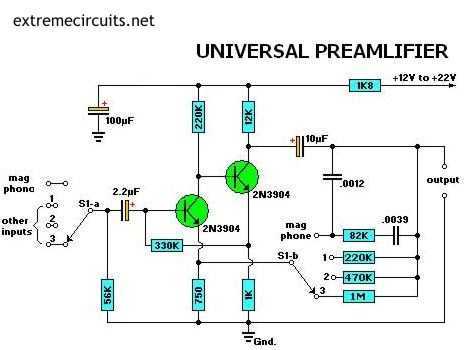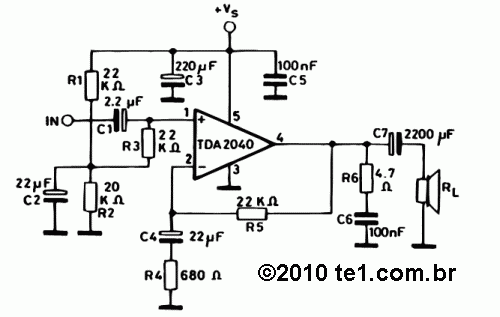
Headphone Buffer Amplifier
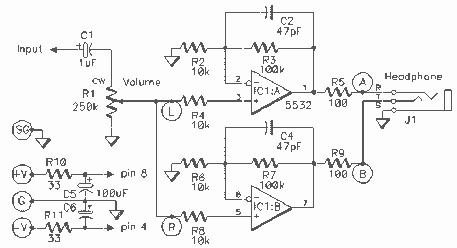
This simple amplifier is ideal for adding a headphone jack to equipment that lacks this feature. The Headphone Buffer circuit board is small enough (1.2" X 1.4") to squeeze into even the smallest spaces and power requirements are so low that existing supplies in retrofitted gear can be used. It's a useful addition to many PAiA products such as the Submixer or Submix-Master. Adding a headphone output turns a Stack-In-a-Box into an incredible practice amp. The key component is the 5532 Dual OpAmp. While ordinarily this part is chosen for its low noise characteristics, it is also capable of delivering nearly 350mW of output power per side, more than enough to drive headphones. The circuit can operate from bipolar voltages from +/-5V to +/-18V and it is not absolutely necessary that the + and - supply voltages be the same magnitude. The superior supply voltage rejection of the IC allows operation with unregulated supplies.
In the typical mono application such as adding headphones to a FatMan or Theremax, the Left and Right inputs of the amp are both connected to the Volume control supplied with the kit. For stereo applications, a dual ganged pot should be used and this modification is covered in the instructions.
The Headphone Buffer amp kit includes a circuit board, all electronic components, a 1/4" Stereo Jack, Volume control with knob, wire, and assembly instructions.
The Headphone Buffer circuit is designed to enhance audio output capabilities for devices lacking built-in headphone support. The compact dimensions of 1.2" x 1.4" ensure that the circuit can be integrated into various enclosures without occupying excessive space. The low power consumption of the circuit allows it to utilize existing power supplies found in retrofitted equipment, making it an efficient solution for audio enhancement.
The core of the circuit is the 5532 Dual Operational Amplifier, which is recognized for its low noise performance and high output capability. With an output power of approximately 350mW per channel, the amplifier can effectively drive headphones, providing clear and powerful audio. The operational range of the circuit spans bipolar supply voltages from +/-5V to +/-18V, offering flexibility in integration. The ability to operate with unequal supply voltages further simplifies installation in various setups, especially when using unregulated power sources.
In typical mono configurations, such as those implemented in PAiA devices like the FatMan or Theremax, the circuit allows for straightforward connections to a volume control, facilitating user-friendly audio adjustments. For stereo applications, the use of a dual ganged potentiometer is recommended, ensuring balanced audio output across both channels.
The kit is comprehensive, containing all necessary components for assembly, including a circuit board, a 1/4" stereo jack for headphone connectivity, a volume control with knob for user interface, and wiring to facilitate connections. Detailed assembly instructions are provided to guide users through the installation process, ensuring a successful integration of the headphone buffer into existing audio equipment. This amplifier circuit not only enhances functionality but also significantly improves the user experience by enabling headphone monitoring capabilities.This simple amplifier is ideal for adding a headphone jack to equipment that lacks this feature. The Headphone Buffer circuit board is small enough (1.2" X 1.4") to squeeze into even the smallest spaces and power requirements are so low that existing supplies in retrofitted gear can be used. It's a useful addition to many PAiA products such as the Submixer or Submix-Master. Adding a headphone output turns a Stack-In-a-Box it into an incredible practice amp. The key component is the 5532 Dual OpAmp. While ordinarily this part is chosen for it's low noise characteristics, it is also capable of delivering nearly 350mW of output power per side, more than enough to drive headphones. The circuit can operate from bipolar voltages from +/-5V to +/-18V and it is not absolutely necessary that the + and - supply voltages be the same magnitude.
The superior supply voltage rejection of the IC allows operation with unregulated supplies. In the typical mono application such as adding headphones to a FatMan or Theremax, the Left and Right inputs of the amp are both connected to the Volume control supplied with the kit. For stereo applications a dual ganged pot should be used and this modification is covered in the instructions.
The Headphone Buffer amp kit includes circuit board, all electronic components, 1/4" Stereo Jack, Volume control w/knob, wire and assembly instructions. 🔗 External reference
In the typical mono application such as adding headphones to a FatMan or Theremax, the Left and Right inputs of the amp are both connected to the Volume control supplied with the kit. For stereo applications, a dual ganged pot should be used and this modification is covered in the instructions.
The Headphone Buffer amp kit includes a circuit board, all electronic components, a 1/4" Stereo Jack, Volume control with knob, wire, and assembly instructions.
The Headphone Buffer circuit is designed to enhance audio output capabilities for devices lacking built-in headphone support. The compact dimensions of 1.2" x 1.4" ensure that the circuit can be integrated into various enclosures without occupying excessive space. The low power consumption of the circuit allows it to utilize existing power supplies found in retrofitted equipment, making it an efficient solution for audio enhancement.
The core of the circuit is the 5532 Dual Operational Amplifier, which is recognized for its low noise performance and high output capability. With an output power of approximately 350mW per channel, the amplifier can effectively drive headphones, providing clear and powerful audio. The operational range of the circuit spans bipolar supply voltages from +/-5V to +/-18V, offering flexibility in integration. The ability to operate with unequal supply voltages further simplifies installation in various setups, especially when using unregulated power sources.
In typical mono configurations, such as those implemented in PAiA devices like the FatMan or Theremax, the circuit allows for straightforward connections to a volume control, facilitating user-friendly audio adjustments. For stereo applications, the use of a dual ganged potentiometer is recommended, ensuring balanced audio output across both channels.
The kit is comprehensive, containing all necessary components for assembly, including a circuit board, a 1/4" stereo jack for headphone connectivity, a volume control with knob for user interface, and wiring to facilitate connections. Detailed assembly instructions are provided to guide users through the installation process, ensuring a successful integration of the headphone buffer into existing audio equipment. This amplifier circuit not only enhances functionality but also significantly improves the user experience by enabling headphone monitoring capabilities.This simple amplifier is ideal for adding a headphone jack to equipment that lacks this feature. The Headphone Buffer circuit board is small enough (1.2" X 1.4") to squeeze into even the smallest spaces and power requirements are so low that existing supplies in retrofitted gear can be used. It's a useful addition to many PAiA products such as the Submixer or Submix-Master. Adding a headphone output turns a Stack-In-a-Box it into an incredible practice amp. The key component is the 5532 Dual OpAmp. While ordinarily this part is chosen for it's low noise characteristics, it is also capable of delivering nearly 350mW of output power per side, more than enough to drive headphones. The circuit can operate from bipolar voltages from +/-5V to +/-18V and it is not absolutely necessary that the + and - supply voltages be the same magnitude.
The superior supply voltage rejection of the IC allows operation with unregulated supplies. In the typical mono application such as adding headphones to a FatMan or Theremax, the Left and Right inputs of the amp are both connected to the Volume control supplied with the kit. For stereo applications a dual ganged pot should be used and this modification is covered in the instructions.
The Headphone Buffer amp kit includes circuit board, all electronic components, 1/4" Stereo Jack, Volume control w/knob, wire and assembly instructions. 🔗 External reference
